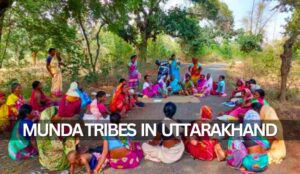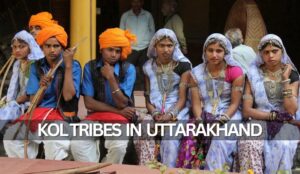Towering over the Western Garhwal Himalayas in Uttarakhand, India, lies the majestic Bandarpunch massif. Its name, literally translating to “monkey’s tail” in Hindi, evokes a sense of wonder and intrigue. But this isn’t just any mountain; Bandarpunch is a formidable giant, a playground for mountaineers, and a breathtaking spectacle for trekkers.
This article delves into the heart of Bandarpunch, exploring its geographical grandeur, historical significance, and the challenges and rewards it offers adventurers.
A Multi-Peaked Majesty
Bandarpunch isn’t a solitary peak, but rather a massif comprising three distinct summits. The highest and most prominent is Bandarpunch I, reaching a staggering height of 6,316 meters (20,700 feet). Standing tall beside it is Bandarpunch II, also known as the White Peak, at 6,102 meters (20,016 feet). Completing the trio is Kalanag, meaning “Black Peak,” which stands slightly taller than Bandarpunch I at 6,387 meters (20,986 feet).
The unique formation of these peaks, particularly Bandarpunch I and II when viewed from a distance, is said to resemble a monkey’s tail, hence the name. This intriguing origin story adds another layer of charm to this magnificent mountain range.
Geography and Location
Bandarpunch forms part of the Sankari Range, nestled within the Govind Pashu Vihar National Park and Sanctuary. This protected area is a haven for diverse flora and fauna, making the trek to Bandarpunch an experience not just for mountaineers, but for nature lovers as well.
Geographically, Bandarpunch sits at the western edge of the high Himalayan range, marking a bend towards the northwest. This positioning offers stunning panoramas of the surrounding Himalayan giants, making the summit a truly rewarding achievement.
One of the most significant aspects of Bandarpunch’s location is its proximity to Yamunotri, the source of the holy Yamuna River. Yamunotri is one of the four sacred pilgrimage sites known as the Chota Char Dham, attracting thousands of devotees every year. The sight of Bandarpunch towering over Yamunotri adds a spiritual dimension to the landscape.
How to Reach
Reaching this peak requires a journey in stages, taking you from the bustling cities to the serene villages nestled in the Himalayas. Here’s how to get there:
1. Reach a major city
Your first step is to reach a major city that acts as a gateway to the Himalayas. Dehradun is the most common starting point, offering good connectivity by air, rail, and road.
- Air: Jolly Grant Airport in Dehradun (DED) is the closest airport to Bandarpunch. From major cities in India, you can find connecting flights to Dehradun.
- Train: Dehradun Railway Station is well-connected to major cities across India.
- Road: Dehradun is a major hub on the national highway network. You can take a bus from various cities or hire a taxi to reach Dehradun.
2. Reach Uttarkashi
From Dehradun, you can proceed to Uttarkashi, a town nestled in the Himalayas and the base for onward journeys to Gangotri and Yamunotri Dhams. Buses and taxis are readily available for this route.
3. Reach Sankri
Sankri, a picturesque village nestled amidst meadows and mountains, is the last roadhead before the trek to Bandarpunch begins. Shared taxis or jeeps can be hired from Uttarkashi to reach Sankri.
4. Trek to Bandarpunch Base Camp
Sankri marks the start of the trek to Bandarpunch base camp. The trail progresses through villages like Osla and Seema, offering stunning views of the surroundings. This trek can be completed in 2-3 days depending on your pace.
The history of Bandarpunch is intertwined with the exploration of the Himalayas. The first successful recorded expedition to Bandarpunch was led by Maj Gen Harold Williams in 1950. This expedition included the legendary mountaineer Tenzing Norgay, who fondly referred to Bandarpunch as “The Doon School Mountain” in his autobiography.
Since then, Bandarpunch has become a coveted challenge for mountaineers seeking a less-frequented yet challenging climb. The mountain’s diverse terrain, ranging from dense forests to alpine meadows and treacherous glaciers, demands both technical skill and physical endurance.
The Climber’s Challenge – A Test of Skill and Will
Ascending Bandarpunch is no easy feat. It’s a demanding climb reserved for experienced mountaineers. The route typically starts from Sukhi village, followed by a two-day trek to the base camp. From there, climbers establish high camps on the glacier before attempting the summit push.
The climb itself presents a multitude of challenges. Crevasses on the glacier demand careful navigation, while the steep slopes test a climber’s physical and mental strength. However, the reward for overcoming these obstacles is unparalleled.
Reaching the summit of Bandarpunch offers breathtaking panoramic views of the surrounding Himalayan giants, including Swargarohini, Black Peak, and countless other snow-capped peaks. The sense of accomplishment and the sheer beauty of the landscape leave a lasting impression on those who conquer this mountain.
Beyond the Climb – A Trekker’s Paradise
For those seeking a less strenuous yet equally rewarding experience, Bandarpunch offers stunning trekking opportunities. The trails leading to the base camp weave through dense forests of pine, deodar, and rhododendrons, offering glimpses of the Himalayas in the distance.
The meadows around the base camp come alive with vibrant wildflowers during spring and summer, creating a picturesque landscape. Trekkers can also encounter various birdlife, including pheasants, lammergeyers, and even the elusive Himalayan monal.
The trek to Bandarpunch base camp is a fantastic opportunity to experience the beauty and serenity of the Himalayas without the technical challenges of a full-fledged climb.
Responsible Exploration – Preserving the Magic
The majesty of this peak comes with the responsibility of preserving its pristine environment. Sustainable trekking and climbing practices are crucial for maintaining the ecological balance of the region. Here are some ways to ensure responsible exploration:
- Leave no trace: Pack out all your waste, including food scraps and wrappers.
- Respect the local flora and fauna: Avoid disturbing wildlife and stay on designated trails to minimize damage to plant life.
- Use eco-friendly toiletries: Biodegradable soaps and shampoos help protect the water sources used by local communities and wildlife.
- Support local communities: Hiring local guides and porters contributes to the economic well-being of the region.
- Minimize campfire impact: Only light campfires when absolutely necessary and use designated fire pits. Ensure the fire is completely extinguished before leaving the campsite.
By following these guidelines, we can ensure that this peak continues to be a source of wonder and adventure for generations to come.
Beyond the Mountain – Exploring the Region
A trip to this peak doesn’t have to end at the base camp or summit. The surrounding Garhwal region offers a plethora of other experiences for visitors. Here are a few suggestions:
- Yamunotri Dham: Pay homage at the source of the holy Yamuna River, a significant pilgrimage site for Hindus.
- Gangotri Dham: Explore the source of the mighty Ganges River, another revered pilgrimage destination.
- Har Ki Dun Valley: Embark on a picturesque trek through this beautiful valley known for its meadows and waterfalls.
- Uttarkashi: Immerse yourself in the spiritual town of Uttarkashi, a gateway to the Gangotri and Yamunotri Dham pilgrimages.
- Wildlife spotting: Take a jeep safari in nearby Rajaji National Park, where you might encounter elephants, tigers, and various bird species.
By incorporating these additional experiences, you can create a well-rounded itinerary that combines the thrill of adventure with the cultural and historical richness of the Garhwal Himalayas.
Conclusion – Bandarpunch
Bandarpunch beckons with its rugged beauty, challenging climbs, and serene trekking trails. Whether you’re a seasoned mountaineer or a nature enthusiast seeking a breathtaking escape, this peak has something to offer. Remember, responsible exploration is paramount to ensure this magnificent mountain continues to inspire and challenge adventurers for years to come. So, pack your bags, embrace the spirit of adventure, and answer the call of Bandarpunch, the monkey’s tail that beckons from the heart of the Himalayas.
FAQs about Bandarpunch
1. What is the difficulty level of climbing Bandarpunch?
This peak is a challenging climb recommended for experienced mountaineers. It requires technical climbing skills, including navigating crevasses on glaciers and handling steep slopes. Good physical fitness and acclimatization are also crucial for success.
2. What is the best time to visit Bandarpunch?
The ideal time to visit this peak for trekking is during spring (May-June) and autumn (September-November). These months offer clear skies, pleasant weather, and favorable trail conditions. Winter brings heavy snowfall, making the climb extremely dangerous, while the monsoon season (July-August) can cause landslides and slippery trails.
3. What is the typical route for a Bandarpunch trek?
The most common route for the Bandarpunch trek starts from Sankri village in the Uttarkashi district. From Sankri, the trail progresses through villages like Osla and Seema, culminating at the base camp. The actual climb involves establishing high camps on the glacier before the final summit push.
4. What are some things to pack for a Bandarpunch trek?
Here are some essential items to pack for a Bandarpunch trek:
- Sturdy hiking boots with good ankle support
- Warm clothing for high altitudes (including thermals, down jacket, and waterproof layers)
- Trekking poles for balance and support
- Crampons and ice axe for glacier navigation
- Headlamp and extra batteries
- First-aid kit
- Sunscreen, sunglasses, and hat
- Plenty of water and high-energy snacks
5. Are there any alternative activities to climbing Bandarpunch?
Absolutely! If a full-fledged climb isn’t your cup of tea, you can still experience the beauty of Bandarpunch through a trek to the base camp. This trek offers stunning Himalayan views, meadows bursting with wildflowers, and the chance to encounter diverse birdlife. Additionally, the surrounding Garhwal region boasts other exciting options like visiting pilgrimage sites, exploring other valleys like Har Ki Dun, or embarking on wildlife safaris.






